We had a full day guided tour by Dr. Samia Rab to Ras Al Khaima, one of the less affluent Emirates, and to Sharjah. I shot another photo as we headed to AUS to pick up Dr. Rab that does a pretty good job of illustrating what it feels like to drive through Dubai:

The raised concrete platform to the right is the Metro. The road we were on is Sheikh Zayyad Road, which runs the length of the UAE. It’s kind of a surreal feeling driving along a strip like this with miles of skyscrapers on either side.
Anyway, after picking up our guide and Dr. Rab, we drove to Ras Al Khaima, which was about an hour and a half away. I snapped a few more photos along the way. First, here is a picture on the way into AUS of several pictures of the Sheikh of Sharjah:

I wouldn’t say these are everywhere, but pictures of the Sheikh are quite common. It’s clear that there are concerted efforts to build “cults of personality” to increase favorability ratings of the dictators of the various emirates. This reminds me of something Mishaal Al Gergawi – the op-ed columnist for Gulf News mentioned: repeated personality cults are unsustainable. Sometimes Sheikhs aren’t charismatic, and putting lipstick on a pig doesn’t make it something other than a pretty pig. In other words, the repeated personality cults that allow the sheikhs to remain dictators will eventually end.
I also snapped this picture of a menial laborer in his standard jumpsuit attire:

There are two things I want to point out in this picture (and the one above it). First, there were lots of menial laborers like this guy wearing either green or orange jumpsuits. I’m not sure why they are required to wear these uniforms, but they all did. Second, notice the grass and foliage in this photo. And notice in the photo above the sprinklers. Keep in mind that the UAE is a desert. It may rain once a year, or even less. We were told that Dubai has just a week of water reserves at any given point in time. And here they are watering grass. I live in Florida, where we get tons of rain and I don’t water my grass. It’s too expensive and makes little sense. But they water grass in the middle of the desert!
On the way to Ras Al Khaima we saw camels wandering around the desert. I snapped a few good shots. Here’s probably the best one:

Our only stop in Ras Al Khaima was at the National Museum of Ras Al Khaima. It is a reconstructed home, but has the only intact and functioning wind tower in the UAE according to Dr. Rab. Here are some photos:


We stood below the wind tower and, even though there was just a slight breeze, it was quite evident that the tower did a good job of cooling the air.
While we were at the National Museum I had to use the restroom and was reminded of a unique cultural feature in the UAE. I’m familiar with bidets. They have been popular in several countries I’ve visited, including Costa Rica (in the wealthy neighborhoods), Japan, and France. In the UAE they have a different method for cleaning up after defecating: a hose with a spray nozzle on it:

You know, I wouldn’t really have an issue with the hose by the toilet… Except, every bathroom also has a free-standing drain in it. You can see the edge of the drain at the bottom middle of the photo. There is a similar drain in all the bathrooms. Now let me connect the dots for you. The bidets I have seen (and, of course, used) in other countries have a sprayer in the toilet itself or a separate bidet with a sprayer built in. The mechanics of such a system mean that the feces removed from spraying the anus end up in the toilet or the bidet. Those bathrooms didn’t include free-standing drains in them. Now think through the mechanics of having a hose with a nozzle. You don’t have to be sitting down to use that hose, nor do you have to be near the toilet. You getting the picture yet? The feces that is removed through spraying the anus doesn’t have to end up in the toilet or bidet, does it? 😉 Thus the free-standing drain! In other words, every time I walked into a bathroom in the UAE, I was basically walking on the mostly cleaned up remnants of other peoples’ feces. Um, yeah. Most of the time I didn’t think about this because the bathrooms were relatively clean. But the place where it was most apparent that I was, in fact, walking on other peoples’ feces was actually in the men’s room at the American University of Sharjah. The stalls in the bathroom by our lecture hall were very small with wooden partitions and wooden doors. Wood is porous. Now add humidity (the UAE is very humid) and more humidity from the hose and sprayer and mix in feces falling on the floor. What do you get? Wood that smells like feces, damp, humid, feces. And I knew it was on the floor because where else would it go when someone pulled out that hose and started spraying? I used the bathroom in my hotel most of the time I was in the UAE; it was pretty clean, but still had the hose and the free-standing drain. Just thought you might like this fun cultural tidbit.
We spent about 30 minutes at the museum then Dr. Rab walked us through the neighborhood behind the museum and to the ocean. The neighborhood was actually one of the most interesting parts of the tour – it was a slum. And it contained labor camp housing. I don’t think our guide realized that Dr. Rab was going to walk us through that neighborhood, but Dr. Rab was able to justify it because the homes are very old (they have been repurposed as labor camps) and employ the traditional architectural style of using coral cemented together. The construction of the homes was interesting, but of greater interest to me was the labor camps and the deprecated nature of the area. Here are some photos:
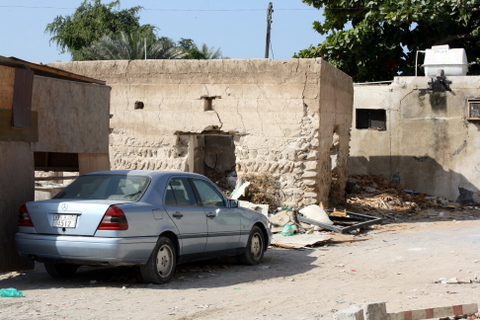
You can tell that buildings are labor camps because they have signs on them with the name of the company that owns them, as did the two buildings in the next two photos:
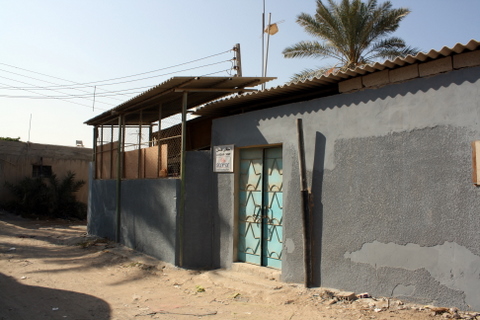

While it was particularly apparent in this rundown neighborhood, something else I noticed in the UAE is that people are fine littering and leaving trashing everywhere. There is no sense of civic duty to clean up after yourself. Jumping ahead a little, I noticed this along the streets as we walked, but also at the beach (see later in this post) as there was trash left all over and in the desert (see next post). This led me to ponder something (which some may want to respond to in the comments): Are countries like the UAE developing too rapidly? What I mean is, in countries that have developed fairly rapidly but through the development of most of their own technology (e.g., Western Europe, the US), it seems as though the culture has shifted along with the technological developments. As a result, there is a sense of civic pride in not littering (in some areas; not everywhere). And that seems to have developed along with the preponderance of packaging that is part of modern life. In a country like the UAE where modernity is very new, corresponding values do not seem to have developed. I don’t mean that to be judgmental; I’m just wondering if that is an accurate observation.
The next photo shows some of the traditional construction. The brown spots in the wall where the top coating has peeled away is coral. Because there are very few rocks in the country, homes were originally built out of coral. The sign on the wall says this is protected for historical purposes:

At the far end of the neighborhood was the ocean. I stuck my fingers in so I could say I have been in the Persian Gulf. This shot shows how far we had traveled along the UAE peninsula as we were near enough to the mountains of Oman for them to appear through the smog:

We walked back through the slum to the museum and got back in the van, then headed to Al Jazirah Al Hamra, which is an abandoned fishing village. Apparently two feuding families had lived here, but their feud had grown so violent that the families eventually picked up and moved to different parts of the country, leaving the village abandoned. Dr. Rab took us there so we could get a better picture of the traditional technique for home construction. Here are two photos showing the materials used:


The village here is a ruin – all of the homes and buildings are falling apart. There used to be a fort here as well but that, too, has begun to collapse. However, a burj (i.e., tower) from the fort was still standing:

We saw similar burjes throughout the country. They were typically facing the desert as enemies (i.e., raiding bedouins) came from the desert while friends came from the sea (most of the time; not the case with Europeans!). Some of these are still intact. Oh, and the nose-shaped protrusion near the top was used for pouring oil on enemies.
From Al Jazirah Al Hamra we traveled into Sharjah along the coast and stopped for lunch in a nice little hole-in-the-wall restaurant in the old souk area. I had my first dates there and they were delicious! From the souk we walked to the Heritage Museum. We took a tour of a home that is being reconstructed and learned more about the construction process. One interesting factoid I picked up had to do with the width of rooms. Since the UAE has no timber to speak of, all the wood used for construction was imported, typically from India. But the boats that brought the wood were only about 8 feet wide, which meant the timber they brought could only be about 8 feet wide. As a result, rooms in the UAE were only about 8 feet wide as the wood was used in the ceiling and roof construction, as shown in this photo:
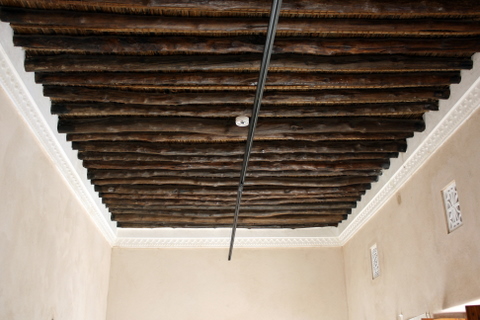
After seeing the houses we had a lecture by three young Emirati ladies who talked to us about Emirati culture. They noted that there are a couple of dishes that are somewhat unique to the UAE, but not many. They also talked about the clothing they wear and customs involving who women can be around. I also asked them about race issues. The book we read before the trip said that there was no discrimination in the UAE based on race, even though blacks used to be owned as slaves. The Emirati women said that wasn’t entirely true. There is a great deal of tolerance, but many Emirati families would not let their children marry an Emirati who is black (I never saw one). In other words, there is racial discrimination in the country. Their presentation was informative and would have been even more helpful the first or second day we were in the country. Here’s a picture of the three of them (they said we could take their picture):

After the presentation by the three Emirati women Dr. Rab gave a presentation on architecture in the Gulf that was informative. She noted that the recent construction boom had changed zoning regulations. Homes now have to be offset from the road by a certain distance. As a result, homes in the UAE, unless they are particularly large, cannot have a courtyard. In traditional homes, there were no windows facing outside the home; all the windows faced the courtyard. This was because of customs involving women and who can see them without the hijab or abaya. When in their own homes they can walk around without the hijab or abaya, but not in public. With the new zoning regulations, the windows in homes all face away from the home rather than toward the courtyard. But that introduces privacy issues as the women can’t be seen by strangers. To address this, all the windows have the shades constantly drawn. And, in consequence, women in the UAE are suffering from a serious Vitamin D deficiency due to limited exposure to the sun. They used to get sunlight in their courtyards, but they don’t have those now. And when they are out and about, they are almost fully covered, so they get limited sun exposure on their skin, reducing their ability to produce Vitamin D. Weird out things tie together. She also noted that there were sitting rooms for men and sitting rooms for women, which meant homes had to be larger to accommodate cultural norms.

Also near the Sharjah heritage area is the old fort, which is actually a complete reconstruction as the old one was torn down. The current Sheikh of Sharjah wanted it rebuilt, so they rebuilt it, but had to move it because the buildings that surround it were built too close to its old foundation:
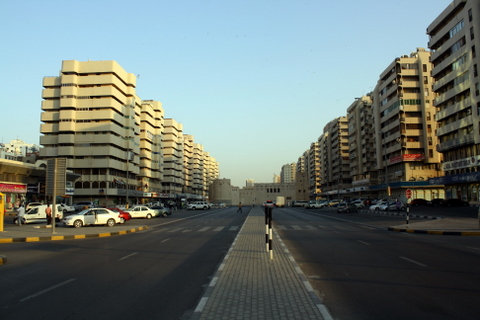
From the Heritage Area we drove to the Sharjah aquarium, which is right next to another site of ruins called Al Khan. Al Khan was where the wealthy people in Sharjah used to go during the sweltering heat of the summer as it was less populated and had more of a breeze from the ocean. Today it is a ruin, but is under restoration. The aquarium has a balcony that offers excellent views of the Sharjah skyline. Here’s a panorama I shot of it:

It was almost sunset when we arrived at the aquarium, so we headed out to the beach to watch the sun set and snapped a few pictures.
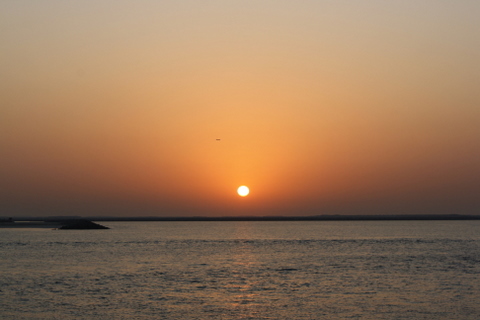

On our way back to the aquarium where we had reservations for dinner we passed a small club house with an open courtyard. Lounging around in the club house and courtyard were half a dozen elderly Emiratis. They waved us over and insisted that we sit and have a drink of Arabic coffee with them. They were very gracious and inviting. We sat and chatted for a minute, but were a little worried as our dinner reservation was for 6:00 and it was almost 6:00. However, just after we sat down the evening call for prayers was issued by the muezzin and they all left to go pray. Awkwardly, we slipped out of the courtyard and headed to the aquarium for dinner.
The aquarium has a beautiful deck right on the water where we had dinner. Here’s the group enjoying dinner:

And here’s a panorama of the view from the deck:

Dinner was delicious and the view was superb.
![]()
Leave a Reply